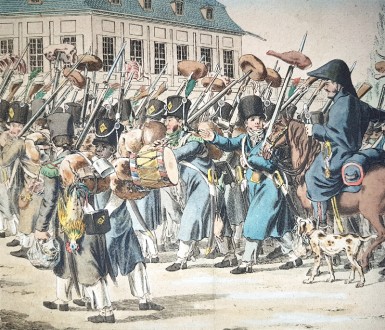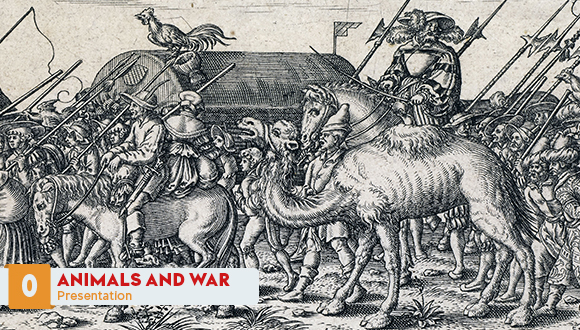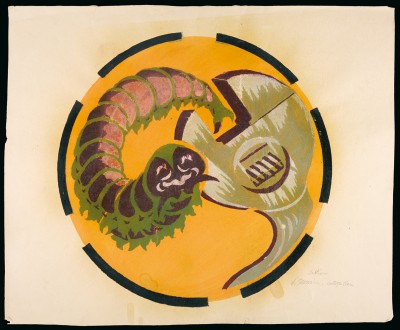
Lead figurine of a signifer of the 12th Roman Legion, 1st century. His equipment was essentially made out of leather and wool and decorated with the effigies of a lion and a wolf. © Paris, musée de l’Armée, dist. RMN-GP / Marie Bour

Detail of an engraving entitled Napoleonic troops make their entrance into Berlin. A dog, man’s faithful companion, and animals for food, chicken, baked ham, are quite visible on this engraving. © Paris, musée de l’Armée
17th century engraving by Jean Theodore de Bry the Younger (1561-1623) depicting a procession. For a very long time, a great number of animals served different functions in the field. The military convoy is composed of troops with bag and baggage and several animals amongst which war-horses and bat-horses for military transport, two dogs with one wearing a collar with bristling pikes, for war, hunting, guard and company. Associated with exoticism and loot from battle, the dromedary also suggests the prisoners to be of Middle Eastern descent, most probably from the Ottoman Empire. Food is represented by four hens, two cockerels, a goose and a wild boar. Completing the allegory, a winged death can be seen riding on an old warhorse at the end of the procession. © Paris, musée de l’Armée, dist. RMN-GP Pascal Segrette
Presentation
This documentary exhibition highlights the role played by animals in wartime with reference to concrete examples of their usefulness. All throughout history, animals have held a multitude of roles in wartime and served as faithful companions in the field. For centuries, they made products such as meat while their skins, bones and teeth produced a wide variety of items for soldiers’ clothing, weaponry and equipment. They also inspired both engineers and researchers in their efforts in developing military hardware. In the military, animals became symbols associated with protection, turning the enemy into derision and codename for operations and military operation and equipment.
These themes are illustrated by the museum’s vast collections, rich in objects representing time periods from before history was recorded to the present day, and creating, when possible, a link with the painted and carved decor of the Hôtel des Invalides.
With so many real animals depicted in military symbols, a second documentary exhibition will be dedicated to fantastic creatures that are made up of a combination of human and animals.
This documentary exhibition presents collections from the Musée de l’Armée and the Library of Congress.
English translation : Nadia Nin, musée de l’Armée
Exhibition curators : Sylvie Picolet, Laëtitia Desserières et Hélène Boudou-Reuzé, musée de l’Armée.
Contact : histoire@musee-armee.fr





Ajouter un commentaire